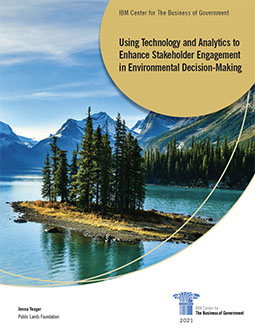
Using Technology and Analytics to Enhance Stakeholder Engagement in Environmental Decision-Making

A key provision in the National Environmental Policy Act (NEPA) calls for public participation in the environmental review of proposed actions by federal executive agencies. The law created the Council on Environment Quality (CEQ) and directed individual agencies to implement NEPA in a manner consistent with their respective department and agency missions.
This report covers NEPA activities as conducted by the four major federal land management agencies: Bureau of Land Management (BLM); National Park Service (NPS); Fish and Wildlife Service (FWS) within the Department of the Interior; and the Forest Service (FS) within the Department of Agriculture (specifically in the area of stakeholder engagement). Together, these four agencies manage over 650 million acres—a sizable portion of America’s public lands.
The research by Jenna Yeager focuses on how stakeholder engagement has been facilitated through the use of technology, such as dedicated agency apps that provide relevant content to stakeholders regarding proposed actions. The report then explores how agencies can use analytics and artificial intelligence to enhance their set of engagement tools.
The author views the NEPA process through the lens of data and analytics, rather than through the more common lens of governmental policy or organizational effectiveness. The reports focuses on the intersection of four components: NEPA, stakeholder engagement, the four land management agencies, and analytics/AI.
The report seeks to identify what type of functionality external stakeholders need and expect when participating in agency NEPA actions. Not surprisingly, the existing stakeholder requirement frameworks were found to concentrate mostly on facilitation, trust building, communication, and similar soft skills—all critical to the success of any endeavor—but were largely silent on tools/technology. For that reason, the report leverages existing sources to create a custom framework containing nine stakeholder requirements, rolled up into three categories. The research also finds that meeting NEPA stakeholder expectations requires holistic service delivery at the agency level, not just within the NEPA program.
Two key takeaways can be derived from this research:
- The four agencies vary in their ability to fulfill the nine NEPA stakeholder engagement requirements; none currently provides adequate support for the highest stakeholder level, collaboration.
- Achieving enhanced NEPA stakeholder collaboration requires improving overall agency service delivery (e.g., data and information), not simply modernizing the key apps that support NEPA.
Yeager acknowledges there is no ‘magic’ path forward, nor are there only technical solutions. Analytics and AI will play an increasingly important role in the future. But in the context of stakeholder engagement, they may enable progress in a manner not necessarily visible to most stakeholders.
This report ends with a summary of near-term and mid/long-term recommendations. Agencies are encouraged to adopt the recommendations that best meet their needs and align with their budgets. This report joins a library of IBM Center research focusing on how technology and analytics can improve decision-making, including: Silo Busting: The Challenges and Successes of Intergovernmental Data Sharing; More Then Meets AI Part I & Part II; Integrating Big Data and Thick Data to Improve Public Service Delivery; and From Data to Decisions I & II.



